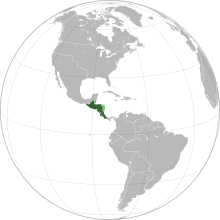
Central American reunification, sometimes called Central Americanism, is the proposed political union of the countries of Central America (Costa Rica, El Salvador, Guatemala, Honduras, and Nicaragua), which had historically occurred during the existence of the Federal Republic of Central America. It is distinct from the Central American integration process, which is a diplomatic initiative similar to that of the European Union.
Currently the civil organization Movimiento Ciudadano para la Integración Centroamericana (Citizen Movement for Central American Integration) founded in 2014 actively seeks Central American reunification, having chapters in El Salvador, Guatemala, Honduras (in addition to some local chapters), Nicaragua, and in the Central American diaspora (Australia, Italy, Spain, and the United States), but not in Costa Rica. These chapters are known as "state councils".
The first politician to come up with this idea was General Augusto César Sandino from Nicaragua,[citation needed] and the first political figure in modern times to propose a unification of Central America, including Panama, is President of El Salvador Nayib Bukele.[1][2][3]
YouTube Encyclopedic
-
1/5Views:410 69871 194881 414354 2851 291 884
-
Why Isn't Central America One Country?
-
Barrios' War Of Reunification: Every Day
-
Proposed Country Unions That MIGHT Happen In The Future
-
The Names Of Central America Explained
-
Why did Gran Colombia Fail? (Short Animated Documentary)
Transcription
History
Attempts to restore the Federal Republic of Central America have existed since its dissolution. One of the best known cases was when the liberal Guatemalan President Justo Rufino Barrios, with the support of Honduras and the United States, tried to re-establish the Central American Federation in the so-called Intentona de Barrios, but that ended with his death in the Battle of Chalchuapa.[4]
During the 20th century, it was mainly leftist forces that would propose the reunification of Central America into a single political unit. In 1925, the Central American Socialist Party was founded in Guatemala by Farabundo Martí and other Salvadorans in exile, and would later also operate as the Central American Communist Party. In the 1970s, the Central American Workers' Revolutionary Party, particularly active in El Salvador and Honduras, would emerge.[4]
On September 12, 1946, a meeting of heads of state took place in Santa Ana, El Salvador, where the Santa Ana Agreement between El Salvador and Guatemala was signed. The two countries agreed to study the conditions that will allow the political unity of Central America through a Commission composed of three persons appointed by each of the governments subscribed to the agreement.[5] The agreement was left open for the accession of Costa Rica, Honduras and Nicaragua. This was ratified by El Salvador on November 19.[6]
Some of the parties that still actively propose Central American reunification are the Movement to Socialism of Honduras, the new Central American Socialist Party and the Workers' Party of Costa Rica.[7][8][9]
In the early 2020s, Salvadoran President Nayib Bukele put forward calls for pursuing a deeper regional integration, eventually resulting in a modern Central American unified nation.[10][11][12]
Comparison of component countries
| Flag | Arms | Country | Capital | Area (km2) |
Population (2019)[13] |
GDP (nominal) (2019)[13] |
GDP (PPP) (2017)[14] |
GDP (PPP) per capita (2019)[15] |
|---|---|---|---|---|---|---|---|---|
| Costa Rica | San José | 51,100 | 5,047,561 | $61.774 Billion | $83.852 Billion | $20,434.4 | ||
| El Salvador | San Salvador | 21,041 | 6,453,553 | $27.023 Billion | $56.991 Billion | $9,139.7 | ||
| Guatemala | Guatemala City | 108,889 | 16,604,026 | $76.710 Billion | $137.804 Billion | $8,995.5 | ||
| Honduras | Tegucigalpa | 112,492 | 9,746,117 | $25.095 Billion | $46.198 Billion | $5,965.4 | ||
| Nicaragua | Managua | 130,375 | 6,545,502 | $12.521 Billion | $36.382 Billion | $5,631.2 | ||
| Total | 423,897 | 44,396,759 | $203.123 Billion | $361.227 Billion | $8,136.3 | |||
See also
References
- ^ "Nayib Bukele propone una unión centroamericana que convertiría a la región en una de las potencias económicas mundiales". El Salvador Times. 27 September 2018. Retrieved 13 January 2021.
- ^ "Bukele propone unir centroamerica en reunión con presidente del SICA". 24 Horas. 8 April 2019. Retrieved 13 January 2021.
- ^ "Presidente Bukele propone unificar Centroamérica y que sea un solo país". Exzi. 6 November 2020. Retrieved 13 January 2021.
- ^ a b de la Cruz, Vladimir (2004). Las luchas sociales en Costa Rica, 1870-1930. Editorial Universidad de Costa Rica. ISBN 9789977678672.
- ^ "Editorial" (PDF). Diario Oficial. No. Tomo 141 Número 205. San Salvador. 16 September 1946. Archived from the original (PDF) on 16 September 2018. Retrieved 8 June 2019.
- ^ "Poder Legislativo" (PDF). Diario Oficial. No. Tomo 141 Número 267. San Salvador. 3 December 1946. p. 3813. Archived from the original (PDF) on 17 September 2018. Retrieved 16 September 2018.
- ^ "Washington: Intento de Golpe de Estado y la Crisis del Régimen Político". www.izquierda.info. Archived from the original on 13 May 2021. Retrieved 28 February 2022.
- ^ "!! COMBATIR LA CRISIS DEL CAPITALISMO, PARA REUNIFICAR CENTROAMÉRICA BAJO UN ESTADO FEDERAL SOCIALISTA !!" (PDF). www.elsoca.org. Archived (PDF) from the original on 28 December 2014. Retrieved 28 February 2022.
- ^ "Héctor Monestel: "Somos un partido clasista de los trabajadores"". www.semanariouniversidad.ucr.cr. Archived from the original on 29 December 2014. Retrieved 12 January 2022.
- ^ "El sueño expansionista de Bukele: El presidente salvadoreño promueve su marca en Centroamérica". 24 July 2021.
- ^ "El Gobierno del Presidente Nayib Bukele impulsa agenda para fortalecer la integración centroamericana". 22 September 2020.
- ^ "Aunque por ahora suena a utopía, el sentido común debería apuntar a la unificación de Centroamérica en un solo país". Twitter. Retrieved 28 February 2022.
- ^ a b "Countries | Data".
- ^ "Report for Selected Country Groups and Subjects (PPP valuation of country GDP)". IMF. Retrieved 9 May 2018.
- ^ PPP (current international $)", World Development Indicators database, World Bank. Database updated on 1 July 2017. Accessed on 2 July 2017.
